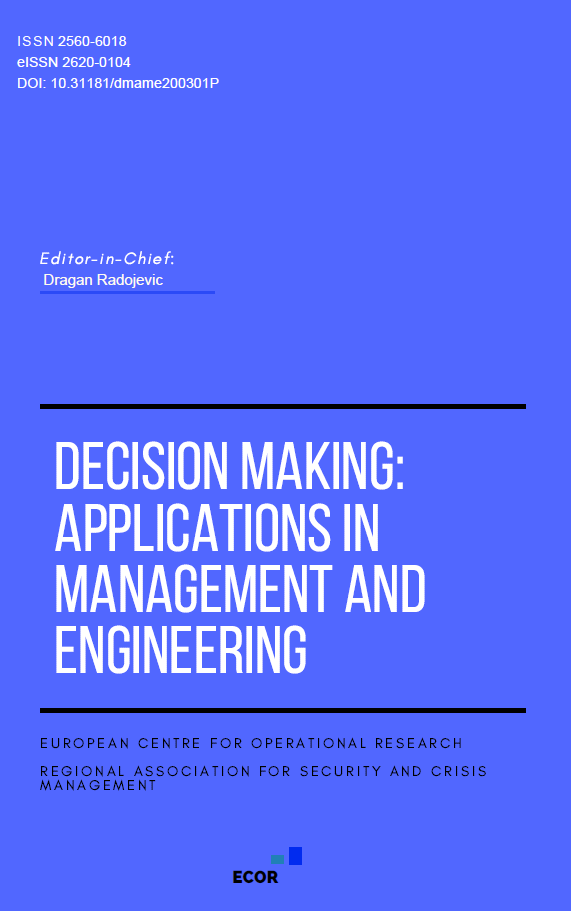An AI-Driven Decision Support Framework for Ergonomic Optimization in Fashion Manufacturing: Integrating Predictive Analytics and MCDM Techniques
DOI:
https://doi.org/10.31181/dmame7120241449Keywords:
Artificial Intelligence, Predictive Analytics, Sustainable Fashion, Supply Chain Optimization, Trend Forecasting.Abstract
The integration of Artificial Intelligence (AI) with predictive analytics is catalysing digital transformation within the fashion industry, reshaping operational procedures and influencing decision-making practices. This study introduces a decision-making framework that leverages predictive modelling techniques in conjunction with Multi-Criteria Decision-Making (MCDM) methods to enhance ergonomics in fashion manufacturing. The framework recognises the pivotal role of AI in facilitating automated design processes and inventory forecasting, alongside optimising supply chain operations to promote sustainable ergonomic practices. Specifically, the framework employs Autoencoder Recurrent Neural Network (RNN) models—advanced deep learning methods—to deliver improved accuracy in forecasting customer demand and identifying consumer preferences. AI-powered generative design contributes to reduced material waste and enhanced production efficiency, aligning with the goals of operational excellence and ergonomic compliance. Moreover, intelligent logistics systems and Internet of Things (IoT)-driven analytics within supply chain management support cost reduction and risk mitigation efforts. To systematically assess and prioritise ergonomic considerations, the Analytic Hierarchy Process (AHP) technique is incorporated into the framework. This integration facilitates structured evaluations of alternatives, enabling transparent and data-informed decisions that strike a balance between worker comfort, sustainability, and productivity. Additionally, AI applications in fashion retail enhance the consumer experience by enabling virtual product trials, delivering personalised recommendations, and providing interactive digital support. The adoption of AI in fashion retail is largely attributed to its capabilities in simulating product testing and offering tailored customer services, including digital assistance. The proposed framework thus supports sustainable manufacturing practices and worker well-being while fostering robust, data-centric managerial decision-making. Ultimately, the integration of MCDM with predictive analytics and AI forms the foundation for achieving responsible operations and human-centred production design, which are critical for the fashion sector's long-term viability.
Downloads
References
[1] Bilderback, S. L. (2025). Examining Workplace Performance and Training for Organizational Sustainability in the Fashion Industry Walden University]. https://www.proquest.com/openview/29869892a08678c242e9990a7eba77c0/1?pq-origsite=gscholar&cbl=18750&diss=y
[2] Bongomin, O. (2025). Positioning Industrial Engineering in the Era of Industry 4.0, 5.0, and Beyond: Pathways to Innovation and Sustainability. https://dx.doi.org/10.2139/ssrn.5096401
[3] Bui, L. T. C., Nguyen, H. T. T., Do, L. T., Huynh, T. V., Ta, T. D., & Duong, A. T. B. (2025). The Advancement of Computer-Aided Design and Computer-Aided Manufacturing in the Fashion Apparel Industry: Toward a Sustainable Development. In Use of Digital and Advanced Technologies in the Fashion Supply Chain (pp. 125-166). Springer. https://doi.org/10.1007/978-981-97-7528-6_7
[4] Cegarra-Navarro, J.-G., Martínez-Martínez, A., Cegarra-Sánchez, J., & Muñoz Faus, J. (2025). Using sustainable enclothed cognition and envisioning sustainable learning to enhance relational capital in the fashion industry. Journal of Intellectual Capital. https://doi.org/10.1108/JIC-10-2024-0300
[5] Chi, C., Xue, J., Zeng, X., Jiang, X., & Zhou, W. (2025). Research status and application scenarios of 3D human body modelling methods in the garment ergonomics: a systematic review. Ergonomics, 1-22. https://doi.org/10.1080/00140139.2025.2459877
[6] De Silva, C. D., Dissanayake, P., De Silva, N., & Thisakya, G. (2025). Ergonomic analysis of dynamic working postures among sewing machine operators. Facilities, 43(3/4), 187-204. https://doi.org/10.1108/F-03-2024-0041
[7] Dey, A., & Mondal, P. (2025). Ergonomic Assessment in the Apparel Industry Using Rapid Entire Body Assessment (REBA) among Workers in India in Finishing Department. Journal of Textile and Apparel, Technology and Management, 13(1). https://orcid.org/0000-0002-0926-6978
[8] Faisal, M. H., Chowdhury, S. S., Ahmed, M. F., & Rahman, Z. (2025). AI-Powered Business Management: Advancing Lean Manufacturing and Sustainable Innovation in the US Fashion Industry. Innovatech Engineering Journal, 2(01), 01-11. https://doi.org/10.70937/itej.v2i01.48
[9] Falcone, P. M., & Fiorentino, R. (2025). Nudging towards sustainability: Exploring the role of behavioral interventions in circular bio‐economy development for the fashion industry. Corporate Social Responsibility and Environmental Management, 32(1), 661-678. https://doi.org/10.1002/csr.2983
[10] Fani, V., Bucci, I., Bandinelli, R., & da Silva, E. R. (2025). Sustainable reverse logistics network design using simulation: Insights from the fashion industry. Cleaner Logistics and Supply Chain, 14, 100201. https://doi.org/10.1016/j.clscn.2024.100201
[11] Firdaus, F., Setyono, P., Gravitiani, E., & Liquiddanu, E. (2025). Key Drivers and Barriers to Circular Economy Practices in the Global Textile and Fashion Industries: Sustainable Strategies for the Indonesian Batik Industry. International Journal of Sustainable Development & Planning, 20(1). http://doi.org/10.18280/ijsdp.200130
[12] Firdhous, M. F. M., & Pirapaharan, A. (2025). Cyborg Technology in Bio Engineering: Enabling Technologies, Implications, Applications and Future Trends. Journal of Human Centered Technology, 4(1), 56-67. https://doi.org/10.11113/humentech.v4n1.90
[13] Ji, X., Al Tamimi, Z., Gao, X., & Piovesan, D. (2025). The Impact of Draw Weight on Archers’ Posture and Injury Risk Through Motion Capture Analysis. Applied Sciences, 15(2), 879. https://doi.org/10.3390/app15020879
[14] Krishnan, A., Yang, X., Seth, U., Jeyachandran, J. M., Ahn, J. Y., Gardner, R., Pedigo, S. F., Blom-Schieber, A. W., Banerjee, A. G., & Manohar, K. (2025). Data-driven ergonomic risk assessment of complex hand-intensive manufacturing processes. Communications Engineering, 4(1), 45. https://doi.org/10.1038/s44172-025-00382-w
[15] Liu, Y., Zhang, B., Qin, J., Zhu, Q., & Lyu, S. (2024). Integrated Performance Assessment of Prefabricated Component Suppliers Based on a Hybrid Method Using Analytic Hierarchy Process–Entropy Weight and Cloud Model. Buildings (2075-5309), 14(12). http://doi.org/10.3390/buildings14123872
[16] Martins, O. O., Oosthuizen, C. C., & Desai, D. A. (2025). Exploring the import of mechatronics engineering in medicine: a review. Beni-Suef University Journal of Basic and Applied Sciences, 14(1), 26. https://doi.org/10.1186/s43088-025-00618-w
[17] Mousavi, S. M., & Naeini, M. J. (2025). Application of the Analytical Hierarchy Process (AHP) in Occupational Health and Safety. http://doi.org/10.5772/intechopen.1008205
[18] Mustajib, M. I., Ciptomulyono, U., & Kurniati, N. (2021). A novel multi-criteria sorting model based on AHP-entropy grey clustering for dealing with uncertain incoming core quality in remanufacturing systems. Applied Sciences, 11(6), 2731. https://doi.org/10.3390/app11062731
[19] Nguyen, T. T. T., & Bui, T. T. H. (2025). Impact of corporate social responsibility on customer satisfaction: a case study of e-commerce fast fashion industry. International Journal of Management Concepts and Philosophy, 18(1), 1-22. https://doi.org/10.1504/IJMCP.2025.142937
[20] Pagliari, C., Montalti, A., Frizziero, L., & Liverani, A. (2025). Enhancing Ergonomic Comfort: A Study on Customized Cushion Design Using 3D Scanning and Additive Manufacturing. Results in Engineering, 104256. https://doi.org/10.1016/j.rineng.2025.104256
[21] Pérez-Soto, M., Marín, J., & Marín, J. J. (2025). L-GABS: Parametric Modeling of a Generic Active Lumbar Exoskeleton for Ergonomic Impact Assessment. Sensors, 25(5), 1340. https://doi.org/10.3390/s25051340
[22] Roozen, I., Raedts, M., & Henderix, M. (2025). Exploring the role of green brand extensions and greenwashing in the fashion industry. Journal of Global Fashion Marketing, 16(1), 32-46. https://doi.org/10.1080/20932685.2024.2396612
[23] Salazar-Salgado, S., Escobar-Saltaren, D., Cuartas-Escobar, S., Calderón, L. A., Posada-Borrero, A. M., & Henao, S. C. (2025). Complementing Cross methodology with Human Centered Design approach: Application in the development of an assistive device. International Journal of Industrial Ergonomics, 105, 103674. https://doi.org/10.1016/j.ergon.2024.103674
[24] Segura, P., Lobato-Calleros, O., Soria-Arguello, I., & Hernández-Martínez, E. G. (2025). Work Roles in Human–Robot Collaborative Systems: Effects on Cognitive Ergonomics for the Manufacturing Industry. Applied Sciences, 15(2), 744. https://doi.org/10.3390/app15020744
[25] Sha, Z., Amjad, A., Ashraf, M., Mushtaq, F., & Sheikh, I. (2016). Ergonomic risk factors for workers in garments manufacturing–A case study from Pakistan. Proceedings–International Conference on Industrial Engineering and Operations Management, 1110-0168. https://doi.org/10.1016/j.aej.2024.12.072
[26] Sheel, C. C. (2025). A systematic approach and mathematical review to textile production optimization: implementing lean six sigma DMAIC for enhanced product consistency and quality in the field of industrial engineering management. Big Data and Computing Visions, 5(1), 37-51. https://doi.org/10.22105/bdcv.2024.485749.1214
[27] Su, R., Aloraini, N. M., Alkhathami, A. A., Alshanbari, H. M., & Khalifa, H. A. E.-W. (2025). A new statistical distribution: Its empirical exploration using the reliability and lifespan data in fashion industry. Alexandria Engineering Journal, 116, 660-671. https://doi.org/10.1016/j.aej.2024.12.072
[28] Tandon, A., Dhir, A., Kaur, P., & Ogbonnaya, C. (2025). Ethical Sourcing and Decision Making in the Fashion Industry: A Longitudinal Qualitative Examination. Journal of Business Ethics, 1-29. https://doi.org/10.1007/s10551-024-05876-9
[29] Wang, C., Zhang, X., Hu, X., Lim, M. K., Xu, Y., Chang, P.-C., & Ghadimi, P. (2025). Dynamics and drivers of global secondhand clothing trade: Implications for sustainable energy and circular economy in fashion. Renewable and Sustainable Energy Reviews, 209, 115116. https://doi.org/10.1016/j.rser.2024.115116
[30] Younus, M. (2025). The Economics of A Zero-Waste Fashion Industry: Strategies To Reduce Wastage, Minimize Clothing Costs, And Maximize & Sustainability. Strategic Data Management and Innovation, 2(01), 116-137. https://doi.org/10.71292/sdmi.v2i01.15
[31] Zeugner-Roth, K. P., Fischer, P. M., & Hessel, I. M. (2025). Authentic Brand Ethicality: Conceptualization, Measurement, and Validation in the Fashion Industry. Journal of Business Ethics, 1-33. https://doi.org/10.1007/s10551-024-05873-y
[32] Zhang, Y., Xie, H., & Newton, M. A. A. (2025). Enhancing Assistive Technology Design: Biomechanical Finite Element Modeling for Grasping Strategy Optimization in Exoskeleton Data Gloves. Medical Engineering & Physics, 104308. https://doi.org/10.1016/j.medengphy.2025.104308
[33] Zoppelletto, A., Santini, E., Rossignoli, C., & Ricciardi, F. (2025). Interfirm Collaboration Enhancing Twin Transition: Evidence from the Italian Fashion Industry. IEEE Transactions on Engineering Management. https://doi.org/10.1109/TEM.2025.3528260
Downloads
Published
How to Cite
Issue
Section
License
Copyright (c) 2025 Decision Making: Applications in Management and Engineering

This work is licensed under a Creative Commons Attribution 4.0 International License.












